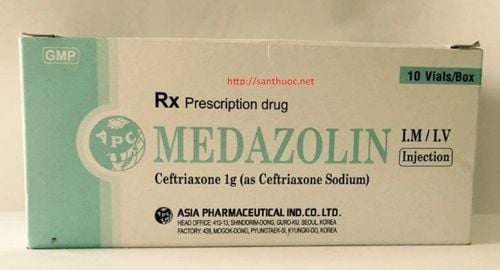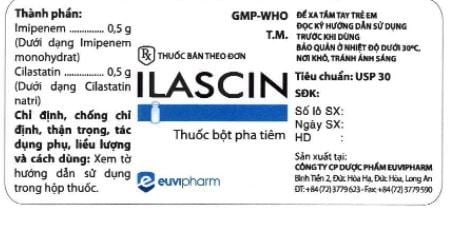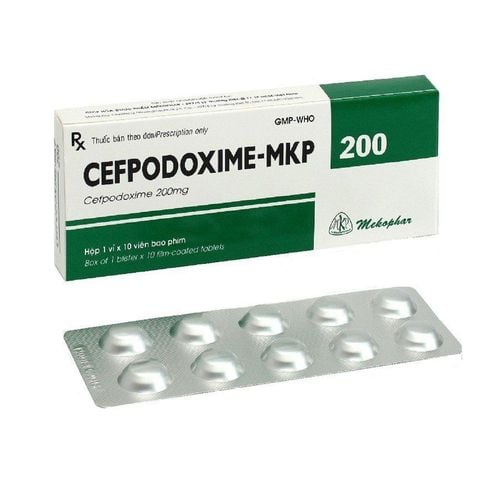This is an automatically translated article.
Tabazo is an antibiotic given by injection, indicated in cases of infections caused by bacteria sensitive to this antibiotic. To ensure the effective treatment of the drug and avoid unwanted side effects, patients need to use Tabazo as prescribed by the doctor / pharmacist.
1. What are the effects of Tabazo?
Tabazo drug has the main ingredients Cefoperazon Sodium 1g and Sulbactam Sodium 1g, prepared in the form of powder for solution for injection.
Cefoperazone Sodium is a semi-synthetic antibiotic, belonging to the 3rd generation Cephalosporin group, with a broad spectrum of action. Bactericidal effect due to inhibition of wall synthesis of growing and dividing bacterial cells. Cefoperazone Sodium is used alone or in combination with other medicinal products to treat infections caused by susceptible bacteria, including upper and lower respiratory tract infections, peritonitis, skin and lower tissue infections skin, endometritis, bacterial sepsis. This drug is given by injection because it is almost not absorbed from the gastrointestinal tract when taken orally.
Sulbactam is used in medicine in the form of Sulbactam sodium, which works by irreversibly inhibiting the Enzyme Beta - Lactamase. This active ingredient only has very weak antibacterial activity when used alone, so it is often used in combination with antibiotics of the Cephalosporin group or Penicillin to reduce the destruction of antibiotics by beta lactamase enzymes. Has good inhibitory activity on both Plasmid and chromosome-mediated Beta - Lactamase types, thereby helping to expand the antibacterial spectrum.
The combination of these two ingredients increases the antibacterial spectrum of the antibiotic Cefoperazone more than when used alone.
2. Indications and contraindications of Tabazo
Tabazo drug is used to treat infections caused by sensitive bacteria in the following cases:
Upper and lower respiratory tract infections: Bronchitis, pneumonia, tonsillitis, pharyngitis...; Septicemia ; Skin and soft tissue infections, bone and joint infections; Peritonitis, cholecystitis, biliary tract infection, other intra-abdominal infections; Gonorrhea, pelvic inflammatory disease, endometritis and other genital infections. Contraindications:
Tabazo should not be used in cases of hypersensitivity to the main active ingredients or excipients in the drug; Contraindicated in patients with hypersensitivity to penicillin and other antibiotics of the cephalosporin group.
3. Usage and dosage of Tabazo
How to use:
Tabazo is used by intramuscular or intravenous injection.
For intravenous injection: 1-2g of the drug can be mixed with 10ml of 0.9% distilled water or physiological saline and then injected slowly intravenously. For intravenous infusion: Dissolve 1-2g of the drug in 100ml of physiological saline solution for slow intravenous infusion. May also be mixed with other compatible solutions. Before injection, the injection site must be disinfected and the drug must be completely dissolved before injection or intravenous infusion.
Dosage should be based on disease severity and weight. You can refer to the dose calculated according to the following Cefoperaone:
Adults:
Dosage for mild to moderate infections: Use at a dose of 1-2g / time, every 12 hours. Severe infections: Use at a dose of 2-4g / time, every 12 hours. Children: 20-40mg/kg/day, in severe cases increase the dose to 80mg/kg/day.
Non-obstructive liver disease: Up to 4g every 24 hours.
Renal failure (requiring dose reduction of Sulbactam):
For creatinine clearance 15 - 30ml/min: The maximum dose of Sulbactam is 1g every 12 hours. For creatinine clearance less than 15ml/min: The maximum dose of Sulbactam is 500mg every 12 hours. Overdose: May experience stimulant effects on nerves and muscles such as seizures. If there are unusual symptoms suspected of overdose, it is necessary to immediately notify the medical staff so that there can be early methods of drug elimination and supportive treatment.
4. Undesirable effects of the drug Tabazo
During treatment with Tabazo you may experience some of the following adverse reactions:
Blood and lymphatic system: Causes a decrease in neutrophils, red blood cells, blood prothrombin, eosinophils and causes a Coomb reaction false positives. Gastrointestinal: Nausea, vomiting, diarrhea. Burning, chills, painful swelling, phlebitis at the injection site. Metabolic: Jaundice, increased liver enzymes. Other: Headache, drowsiness, bloody urine, pruritus, urticaria, rash. You need to tell your doctor right away if you experience side effects so that you can take timely measures.
5. What should be noted when using Tabazo?
Before using the drug you need to tell your doctor about a history of allergy to any agent. You will be tested on the skin before proceeding to use the drug. For people with severe biliary obstruction, poor diet, poor absorption, prolonged IV hyperpigmentation treatment, anticoagulants, severe liver and kidney failure, caution should be exercised when using the drug. Because when used there is a risk of reducing vitamin K causing bleeding reactions. During the use of the drug, it is necessary to regularly monitor the hematological status, kidney and liver function according to clinical indications. Culture tests, antibiograms to identify susceptible organisms, or local resistance data should be consulted prior to initiating treatment. Prolonged use of antibiotics carries a risk of developing non-susceptible organisms. In which pseudomembranous colitis has been reported, monitor for unusual signs such as persistent diarrhea to recognize this condition early. Use of Tabazo in pregnant women and nursing mothers: Currently, there is not enough information and reports on the safety of using the drug for these subjects. Be careful and consult your doctor or pharmacist before use.
6. Drug interactions
Tabazo drug can cause some of the following interactions:
Aminoglycoside antibiotics: When used together, there may be physical incompatibilities if mixed with the drug, if you want to combine it, you need to be injected with cockroaches. wash the infusion tube between two doses or spaced apart. Anticoagulants (Warfarin), thrombolytics, and non-steroidal anti-inflammatory drugs (NSAIDs) with the potential to cause bleeding should not be taken together. When mixed with antibiotics such as Amikacin, Gentamicin, Kentamycin B, Doxycycline, Procainamide, Aminophyllin, Prochlorperazine,... can cause precipitation and change the properties of the drug. Symptoms of flushing, sweating, headache and tachycardia may occur when Tabazo is taken with alcohol. Therefore, do not consume alcohol during and for at least 5 days while taking this antibiotic. Tabazo is an intravenous antibiotic, usually only indicated when oral drugs are ineffective or the infection is severe. However, Tabazo should be avoided as a first-line measure for mild infections.













